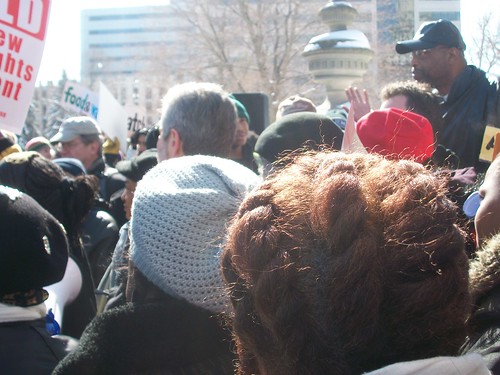
Mass rally in Lansing where Detroit residents and others from around the state came to protest the seizure of public assets and the draconian cutbacks in jobs and public services in the state. (Photo: Abayomi Azikiwe), a photo by Pan-African News Wire File Photos on Flickr.
February 1, 2013
U.S. Adds 157,000 Jobs; Jobless Rate Edges Up to 7.9%
By CATHERINE RAMPELL
New York Times
American employers added 157,000 jobs in January compared with a revised 196,000 jobs the previous month, the Labor Department reported on Friday. The unemployment rate was little changed, ticking up to 7.9 percent from 7.8 percent in December.
Retail, construction, health care and the wholesale trade sector added positions, while the government again shed jobs. Government payrolls have been shrinking almost every month over the last four years.
The monthly jobs numbers were close to what economists had forecast, although many had hoped for an upside surprise. Recent weeks have brought a slew of gloomy economic data, showing that the nation’s output unexpectedly shrank at the end of 2012 and that consumers were becoming increasingly pessimistic about their finances and job prospects.
Dysfunction in Washington over the budget and higher tax rates that kicked in last month could further dampen consumer confidence and hiring early this year.
“The combination of eliminating the payroll-tax forgiveness along with continued stagnation in wages, I think, could be a real hit in terms of jobs,” said Christine Owens, executive director at the National Employment Law Project, a labor advocacy and research group. “If you add in sequestration” — the across-the-board cuts to federal spending currently scheduled for March 1 — “that paints a pretty bleak picture.”
Job growth has been steady but uninspiring in the last year, trudging along just barely fast enough to keep up with population growth but not nearly quickly enough to put a major dent in unemployment. A backlog of 12.3 million idle workers remains.
“I have been working for 40 years and I have looked for jobs many times in the past, including in bad economies, and I’ve never experienced anything like this,” said Mary Livingston, a human resources professional in Wayland, Mass. She was laid off two years ago Friday.
She said she believes employers are reluctant to hire her because of her age — she’s 63 — and the fact that she hasn’t held a permanent job in so long. But she said they seem unwilling to hire anyone at all.
“I’ve seen positions posted two years ago that still have not been filled,” she said. “There seems to be this tremendous fear of making a decision. A lot of my colleagues will go for 15, 20, 23 interviews with the same company.”
Uncertainty over fiscal policy and the fragility of the economy still seem to be holding back employers, despite a number of underlying sources of growth in places like the housing market and auto sales. Economists are forecasting job growth of around 170,000 a month for the rest of 2013, comparable to what employers have been adding over the last year.
Exactly what this pace of job growth means for the unemployment rate depends on whether many of the workers sitting on the sidelines decide to join, or rejoin, the labor force. Right now, labor force participation rates — that is, the share of people of working age who are either working or looking for jobs — is hovering around 30-year lows.
Only those who are actively looking for work are counted as unemployed, so if the labor force participation stays low, even modest job growth can cause the unemployment rate to fall quite a bit.
“The decline in the labor force participation rate brought the unemployment rate down much faster than anyone would have thought, given the jobs numbers,” said John Ryding, chief economist at RDQ Economics. “The aging of America accounts for a little bit of it, but you’d still expect that job searches would go up and participation would rise as opportunities are opening up.”
For the long-term unemployed — who now represent 40 percent of all jobless workers — the opportunities still seem few and far between. Millions have exhausted their unemployment benefits and many more will roll off the government’s system in the coming months with no viable options in sight.
“Who are these people who are getting jobs? Where are they? I don’t know them,” said Karen Duckett, 51, who was laid off from her job as director of housekeeping at a retirement community in late 2011. She recently received a letter saying that her benefits would end in two weeks because the unemployment rate in Maryland, where she lives, has fallen below 7 percent and so the state no longer qualifies for the third tier of federal emergency benefits.
“I am just so angry right now,” said Ms. Duckett, who has been invited for only two interviews despite submitting dozens of applications. “How do you expect for me to find a job in two weeks if I haven’t been able to find one in a year and a half?”
No comments:
Post a Comment